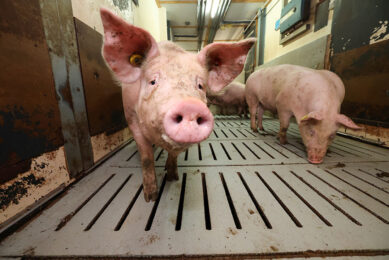Piglets open doors to study infant brain development
Events occurring during the development of an infant’s brain can leave behind fingerprints. And researchers at the University of Illinois are interested in learning how these fingerprints can predict future behavioral problems such as cognitive deficits, anxiety disorders, depression, and even autism. New research shows that the piglets may provide some answers.
Researchers discovered that neonatal piglets are capable of being trained in traditional learning and memory tests. As a result, these piglets can provide critical information that could directly benefit human health.
“Studies suggest that inadequate nutrition, stress, and infection leave fingerprints in early brain development that can make a person more vulnerable to behavior disorders later in life,” said Rodney Johnson, U of I professor of animal sciences and director of the Division of Nutritional Sciences. “We are interested in learning how the brain develops during this time and how cognitive ability is affected. Our goal is to understand how to promote optimum brain and cognitive development, and minimize potential experiential influences that might hinder the process.”
In the study, piglets were weaned from their mothers at 2 days of age and set up with a milk system that delivered 14 small meals a day – mimicking the number of meals they’d receive from their mother. At two weeks of age, piglets were trained to locate a milk reward in an 8-arm radial maze, a large version of models typically used to study rodent behavior. The eight arms of the maze were equipped with a cup exactly like the cup piglets fed from during the day. Seven of the bowls contained inaccessible milk and one bowl contained milk that was accessible. The goal was to teach the piglets how to find the accessible bowl of milk.
Piglets can’t utilize extra-maze cues (such as a picture on a wall) like mice do because pigs tend to keep their nose to the floor. In order to create cues, researchers covered the opening of each maze arm with a blue or white curtain. The piglets learned color cues to remember where to find milk. In the first test, the blue curtain contained the bowl with milk. “The piglets learned quickly after day one where to find their reward,” Johnson said. “This simple associative learning task was not hard for them to complete.
“But then, we did a reversal learning test where the white curtain became the entrance to the cup of accessible milk. This was more complicated because the piglets had to learn to stop going to the blue and then associate white with milk. It required a greater cognitive load, but it was one that they learned over time.” The Johnson lab is currently using MRI imaging to study brain development in piglets from two weeks of age until the piglets reach sexual maturity or an adolescent stage.
The use of the pig in neuroscience research is gaining popularity because pigs are anatomically similar to humans and many of their organ systems grow and develop similarly as well. Pigs are also precocial, meaning they are born with well-developed sensory and motor systems. This allows them to be very mobile and weaned at an early age.
Results of this research project, “Behavioral assessment of cognitive function using a translational neonatal piglet model,” were published in Brain, Behavior, and Immunity. Researchers included Rodney Johnson and Ryan Dilger, both of the University of Illinois.
[Source: EurekAlert]











